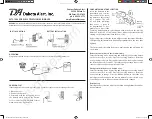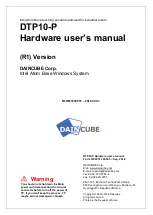
gpelectric.com | [page 11]
4.1 PLACEMENT OF SOLAR PANELS
WARNING: Photovoltaic panels generate DC electricity when exposed to sunlight or other light sources. When
exposed to light, contact with the electricity active parts of the panel, such as terminals, can result in burns, sparks
and lethal shock whether the panel is connected or disconnected.
Do not touch the terminals while the panel is exposed to light. Cover the panel faces completely with an opaque
material to stop the production of electricity when working with panels or wiring – the cardboard shipping boxes
are the perfect option to cover glass surface of the panels.
Panels are not recommended to bend beyond 30° (for 100W Modules, 30° = 2.7”, 69mm Bend)
Site Considerations — Excluded Operating Environments
Certain extreme operating environments are not recommended for Go Power! products and are excluded from the Go Power! limited
warranty. These include (but are not limited to): winds exceeding 45 MPH, flooding or immersion in water or other fluids, contact with
liquids or substances with a pH less than 6.5 or greater than 8.5, and contact with fire, projectiles, lava flow, volcanic eruptions, or
meteors.
Mounting Configurations
Modules installed over a roofing system must be mounted over a flat, fire-resistant roof covering with the appropriate safety rating
for the application. While modules can be mounted at any vertical or horizontal angle, it is recommended that they are installed at a
minimum 10-degree angle to reduce dirt accumulation and soiling.
WARNING:
Do not install panels on a surface that is not fire resistant or that can be damaged by high tempera
-
tures. These panels are designed to not catch fire themselves but can get hot during normal operation and
excessively hot in some failure conditions such as cracked cells or failed protection diodes. Go Power! is
not responsible for heat damage such as discoloration, holes or fire due to improper installation.
Water entering the junction box could present a safety hazard, and junction boxes should be oriented on the uppermost position of
the panel. The junction box should never be mounted in a depression. Note the junction box manufacturer rates this product with an
ingress protection rating of IP67 for the box.
Modules may be attached using an adhesive on the panel backside or by using the grommet holes as attachment points. Go Power!
does not recommend a preferred attachment method or make any claim as to the safety of the attachment.
Mount modules away from obstructions such as vents, AC Units, etc.
Module Handling
Always use gloves when handling modules. Modules are sensitive to oils and abrasive surfaces — not doing so may lead to scratching
and soiling. Minimize module contact as much as possible, especially with any abrasive surfaces. Do not place anything on the mod-
ules. Do not lift modules by the cables or the junction box under any circumstances. Remove fingerprints from the panels by washing
the panel as described below.
The panels are designed to withstand a 30-degree bend top to bottom (with the junction box placed on the top end) — approximately
8cm of deflection. Care must be taken not to bend, flex, or twist panels excessively when handling. Do not place sharp objects on the
panels — this may cause a puncture or damage, resulting in decreased power and creating a potential safety hazard.
Do not use blunt or sharp force with other hardware (junction boxes, cables and connectors). The resulting damage could render the
module unusable.
1. Remove shipping plastic from panel
2. Expose the panel(s) to sunlight and use a voltmeter to test for DC Voltage
3. Locate the solar panels on the RV roof replacing each of the boxes used in the planning step.
4. Locate the Cable Entry Plate / Fridge Vent or Access Point on the roof.
5. Attached the MC4 Positive and Negative Extension Cables to the solar panel(s).
6. Test that the end solar panel cables can reach the GP-CEP / Fridge Vent or Access Point.
Note
INSTALLATION
Summary of Contents for Go Power! Solar Flex Kit GP-FLEX-110
Page 2: ......




































